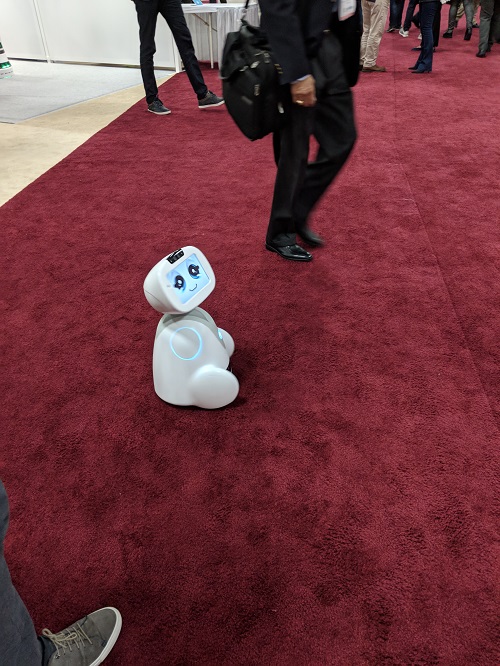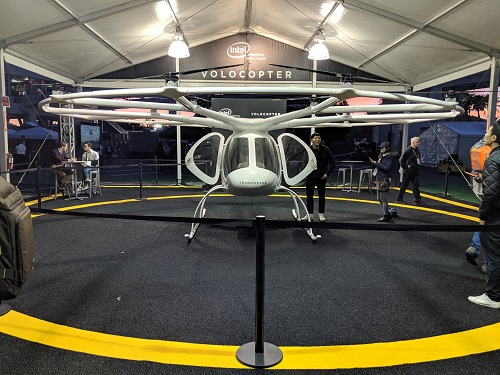By Patrick Mannion, contributing editor
About three weeks ago, I was treated to my first two-middle-finger salute by a young lady who seemed really upset with me. It was a dark night and she didn’t have headlights on, so I didn’t see her vehicle as I moved slowly into her lane. She took offense, of course, it being New York. I rolled down the window to try and explain that she needed to put on her lights in case there was a real accident, and that’s when I noticed her two digits and irate screaming. I figured that it was best to move on.
That incident came to mind as I walked the floors of CES 2018 and soaked in all of the smart gadgets and gizmos and the ever-present demos of vehicles at various stages of autonomy. It seemed that every automobile manufacturer had a demo: Toyota, GM, Volkswagen, Cadillac, Ford, and BMW. And there were various startups founded by entrepreneurs from Waymo and Uber.
On Day 2 of the show, Jim Hackett, president and CEO of Ford, gave the keynote that focused on its ongoing strategy to become a data company as much as a vehicle company. His goal is to transform Ford into a company that does make vehicles but also uses data on user habits, the local environment, and the city itself to make a better overall experience and add more value for the driver and the city. It may not be a coincidence, but Brian Krzanich, who had to spend much of his keynote dealing with the Meltdown and Spectre security scare, has also worked on focusing Intel on data, which is ironic, given the insecurity of data highlighted by the security scare.
Even though Krzanich’s CES presence was hijacked by a topic that arose the week before the event, he still managed to make his data point. And it’s an important one to make, given that autonomous vehicles are becoming data vacuums. They have to be in order to make them safer, but they also need to be fully aware of what customers do and want so that value-added services can be offered as the intrinsic value of a car goes down. Services will be king.
Of course, moving all of that data around the vehicle and to the outside world will be difficult, which is why Marvell and Molex showed up at CES, in part to show their full support of automotive Ethernet. The case for automotive Ethernet is strong, said Will Chu, automotive business unit director for Marvell, given that it reduces harness weight through the use of UTP wiring, is low-cost, is well-understood, has gigabit/second rates, and has the full backing of the IEEE 802.1 and 802.2 groups. While much of the high-speed data will be for infotainment, as the number of sensors grows, the use of Ethernet switches will likely increase as vehicles become re-architected and aggregate the myriad networks now in a vehicle through an Ethernet-based gateway.
While many have pooh-poohed the idea of autonomous vehicles, especially near-term, the concepts and alliances required to make it happen are emerging surprisingly quickly. For sure, functional verification and testing will take time. The software will be rife with bugs or errors in logic, but the pull for autonomous vehicles is getting stronger. Among millennials, it’s more fun to be texting, Snapchatting, Instagramming, Pinteresting, or simply talking on the phone. For baby boomers, having a vehicle that can take them anywhere they want without having to hire a chauffeur or get into a stranger’s car is becoming more and more attractive as the maladies of age creep in. For professionals on the go, being able to file a report is more useful than sitting in traffic on the way to or from work. There was a time when having a vehicle was the ultimate freedom. Now not having to drive that vehicle is the next instantiation of that freedom.
Personally, I find driving boring and frustrating. In cities, it’s a headache, and on quiet roads, you can’t “let ’er rip” because I’m of the age where I see the downside of doing so more than the upside thrill. I’m happy to let my wife drive because she likes to do it. Yet she spends half of her time complaining about all of the idiots on the road, so she doesn’t really “enjoy” the experience, and neither do I.
Of course, the government is fully behind autonomous vehicles, declaring that it would save tens of thousands of lives per year that are caused by human errors. However, that doesn’t seem to factor in that there will be lots of autonomous vehicle errors, too, as they come online. The tricky part is that there’s going to be a long crossover point during which there will be autonomous and human-driven vehicles. How many driverless vehicle passengers will be killed as we climb the learning curve? By the same token, how many drivers will be killed by autonomous vehicles that make errors directly or that behaves in a way different than unaccounted-for circumstances would require?
That said, it’s encouraging to see so many companies partner with Blackberry for its QNX software. Not only is QNX the go-to automobile software platform, but the folks at Blackberry are also experts in security, which is critical for connected vehicles. Just before CES, China’s Baidu and Blackberry announced their partnership, which followed on the heels of Blackberry’s partnership with Qualcomm, Denso, and Aptiv.
Technologies that are changing the world
Picking out autonomous vehicles from the mass of technology at CES is easy because it’s one of those technologies that, while aspirational, just getting there will see a raft of innovations that will change the world. Other gadgets on display at CES include the usual raft of audio and TV improvements, including folding displays and the Super X-Fi headphones from Creative Labs that recreate a full soundstage effect. However, these won’t change the world, nor will connected alarms and doorbells, or app-controlled skateboards, or most of the thousands of gee-whiz gadgets on display.
What will change the world are robots, IoT, artificial intelligence, and VR/AR. The dancing robot may not be the best example (Fig. 1 ). However, the emergence of robots into factories and manufacturing is already profoundly changing workforce dynamics, and for some, it may also soon alter the state of personal relationships as they get more humanlike in their responses.

Fig. 1: Dancing robots may not change the world, but the learnings acquired from developing them, combined with artificial intelligence like Google Home, just might.
Google Home, for example, was everywhere, and once it’s embedded in a human-like form, it may be a game-changer.
As for virtual reality, it may not be directly connected to our cerebral cortex just yet, but William Gibson’s concept in “Neuromancer” of being “jacked in” is not too far away.
If all this gets to be a bit much, CES also had on display a personal drone helicopter. The Velocopter might a good way to rise above and get away from it all (Fig. 2 ).

Fig. 2: When things get to be too much, Intel’s Velocopter flying car might be just what’s needed.
It sure would have come in handy shuttling around Vegas among a throng of 170,000 people. It may be in its trial stages, but I can think of a young woman from Long Island that I’d like to see try it out first.
Advertisement
Learn more about Electronic Products Magazine





